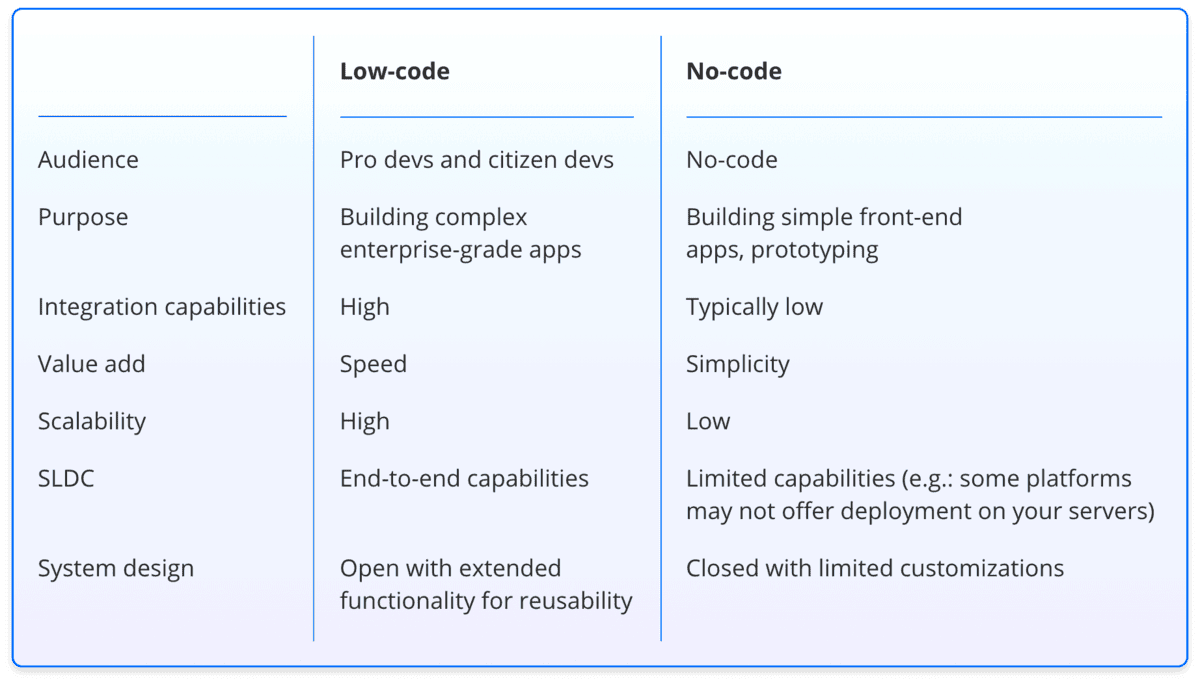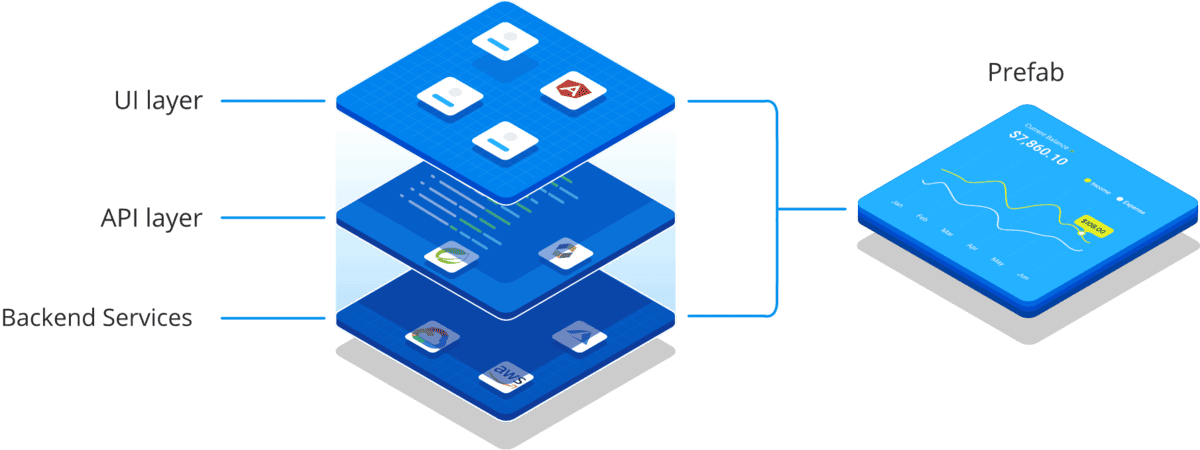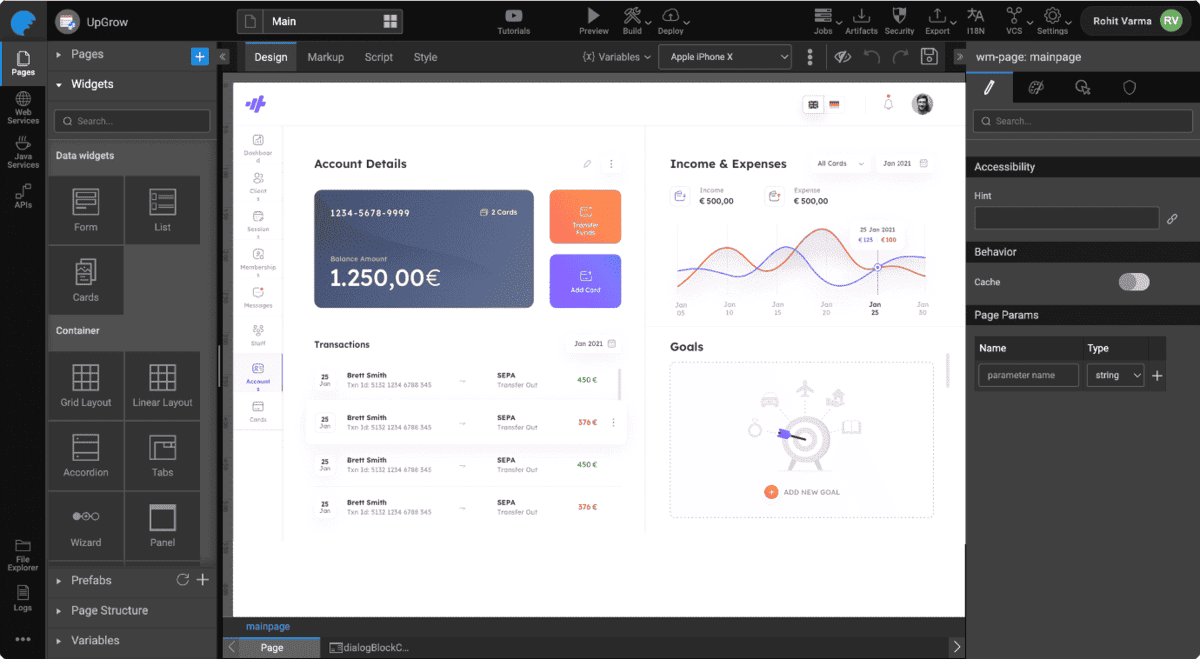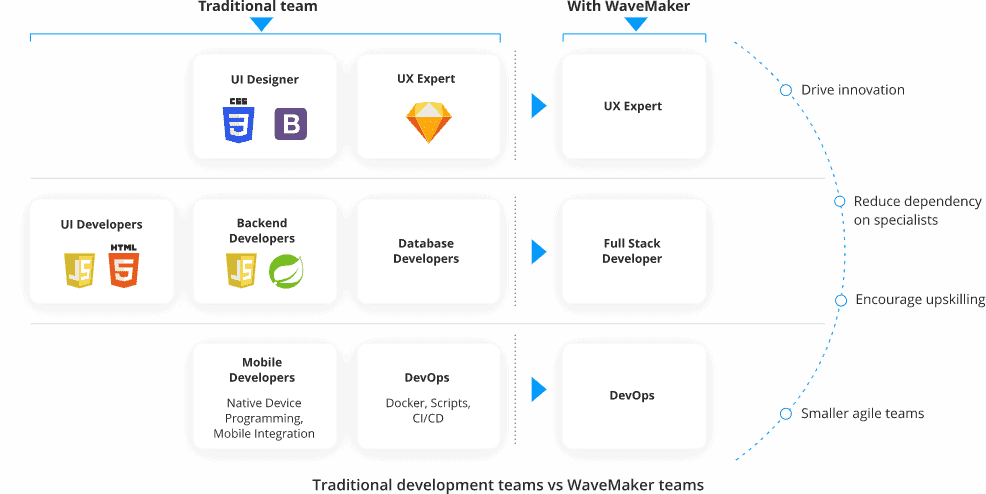The low-code market has been growing at over 20% CAGR y-o-y. Forrester suggests that the reason is “institutionalization of low-code,” which is the widespread adoption of low-code platforms and technologies within the software engineering departments. So much so that 87% of enterprise developers use low-code in some form or another.
As the industry makes the slow and cautious shift from all-manual development towards adopting low-code, there are significant gains in efficiency, speed, agility, and quality to be realized. Let’s see how.
But first, what is low-code?
WHAT IS LOW-CODE?
Low-code is a software development approach that accelerates product delivery by enabling developers to build custom applications with minimal hand-coding. It creates a level of abstraction for the technical elements such as business logic and databases, presenting them visually in the integrated development environment (IDE).
With a visual interface, pre-built templates, integrations, and more, low-code serves to automate a significant portion of the software development process. While the low-code trend began to address “citizen developers,” i.e, business users without programming expertise, it has evolved to meet the sophisticated needs of professional developers as well.
HOW IS LOW-CODE DIFFERENT FROM NO-CODE?
Low-code and no-code platforms primarily arise from the rapid application development (RAD) school of thought. But they’re different from each other in several ways.
As the name suggests, low-code reduces the need for coding, while no-code eliminates it. But there’s more.

How does low-code development work?
Low-code combines a number of complementary features to create value throughout the software development life-cycle. Here’s how.
Visual approach to software development
Low-code platforms offer a visual interface with drag-and-drop functionalities and model-driven logic to automatically generate code in the background. This enables developers and non-developers alike to build complex applications without writing extensive lines of code.
Reuse of components with prefabs
Low-code development platforms come equipped with a library of pre-built templates and components—also known as prefabs—covering a wide range of common functionalities and user interface (UI) designs.

You can customize or combine prefabs to create sophisticated applications. On many platforms, you can also create and save your own enterprise prefabs for reuse.
Low-code development tools seamlessly integrate with existing databases, APIs, and external services. This enables developers to enhance their applications with real-time data access, third-party services, and legacy system functionalities.
Whether it’s incorporating customer data from a CRM system, connecting to payment gateways, or integrating with IoT devices, low-code development platforms accelerate the creation of connectors and APIs necessary to create connected solutions.
Low-code development goes beyond coding to testing, deployment, scaling, monitoring, and maintenance. It supports agile development practices, including continuous integration and delivery (CI/CD).
With built-in scalability options, low code development applications can grow to meet increasing user demands without compromising performance. Moreover, low-code application management tools offer comprehensive insights into usage and performance to support operations teams as well.
WHO IS LOW-CODE DEVELOPMENT FOR?
If you’re looking to develop software, (LCDP) low-code development platform can be for you. Some scenarios that low-code is great are:
You are short of pro devs
Hiring and onboarding can be hard. If you’re short of professional developers, you can enable business users to create low-code development solutions for simple, small-scale/ internal apps.
Your pro devs feel underutilized
Coding is a lot of grind work that experienced developers don’t need to waste time on. Low-code allows pro devs to:
You’re an ISV
Independent software vendors (ISVs) need to build at scale, while also rolling out customized products to elite clients. Low-code development makes it easier to create composable experiences and deploy them at scale.
WHY DO ORGANIZATIONS NEED LOW-CODE?
Speed, efficiency, quality, cost savings, agility, innovation—you name it, low-code delivers across all software engineering goals.
Low-code application platform (LCAP) accelerates development with pre-built templates and UI components. It prevents developers from repeatedly reinventing the wheel. This means:
In the agile software development world, low-code adds another layer of capabilities. It enables teams to build fast and be agile. With low-code applications, senior developers can focus on solving business problems more than writing/debugging code. This means:
Low-code development is an extraordinary innovation tool, if only for the fact that it reduces the cost of experiments significantly. If you’d like to test an out-there product that could disrupt the market, you don’t need to spend millions of dollars and half a year to get the MVP out to customers. This is also true for partnerships and collaboration with complimentary products.
Therefore, low-code app development platform fosters a culture of innovation and experimentation within the organization, empowering business and tech users to quickly create products/prototypes and test them in the marketplace. It does all this and more while allowing everyone access to the latest Low-code development technology and practices.
Unlike no-code—which is highly limiting—low-code development platforms allow you the best of both worlds. You can reuse and automate some parts of the process while retaining control over those you want to custom code.
This Low code flexibility allows you to create unique, personalized experiences, differentiated from your competitors.
A low-code development platform also acts as a collaborative space, even though it’s most definitely not a Slack or Email replacement. A low-code development platform allows developers to track revisions, share feedback/comments, expand on user stories, and more. As conversations happen within the low code application platform, it is also contextual and more meaningful.
One of the biggest challenges in scaling software development is governance. DevOps and security teams often watch disappointed as things fall through the cracks. low code app development platform can be a security/compliance vulnerability. In cases of an unutilized server, for instance, it can also be an unnecessary expense.
Low-code app development platform streamlines governance, minimizes shadow IT, and enables better visibility and control for a sprawling app stack.
Low-code is no longer a small fish. Today’s low-code platforms have enterprise-grade capabilities, enabling organizations to undertake large-scale transformation projects with ease. With low-code development, this quality of software is upheld even when developed by citizen developers or business users with no experience in coding.
Lastly, low-code development is far more cost-effective than traditional development.
Low-code application development platform is the natural next step in the RAD journey. As markets evolve and customers demand more, enterprises need to respond with digital solutions more quickly. Here are a few low code use cases you can get started on right away.
WHAT ARE THE KEY CHALLENGES
IN ADOPTING LOW-CODE?
For traditional engineering teams, low-code is a new way of developing software. Naturally, this brings challenges and complexities.
WHAT DO ENTERPRISES NEED TO
SUCCESSFULLY ADOPT LOW-CODE?
For successful low-code adoption, organizations need to acknowledge that low-code is not a fad you’re trying, but a strategic intervention to your software engineering landscape. With that in mind, here are some ways to improve outcomes.
Low-code adoption is as much a business initiative as it is a tech initiative. Before you onboard a low-code platform, get buy-ins from business leaders. Outline the business goals that low-code will achieve and set up a direct line of sight from adoption to outcomes.
Low-code adoption often fails because someone paid for the platform and sent an email asking everyone to use it. Everyone, of course, promptly ignored the email and the tool.
To successfully integrate low-code into your software development landscape, create a change management strategy.
In traditional development, a lot of governance is in the minds of the engineering leaders. As they review and oversee the teams, these practices are enforced. With low-code, this isn’t necessary.
To mitigate risks, set clear governance frameworks for the low-code platform to enforce. Define policies and procedures for security, compliance, data protection, and development standards. Set up monitoring for early warning signs.
Even the most intuitive platform needs a bit of a push in the beginning. Invest time and resources in training developers on your new low-code platform. This needn’t be a boring presentation. It can be a collaborative workshop. Or a hackathon using only the low-code platform (and no hand-coding). Such activities help developers try their hand at the low-code platform without disrupting regular programming!
Instead of a big-bang approach, introduce the low-code platform to the teams in phases. Sign up pilot users who will try and offer feedback. Incorporate that feedback and implement it for a larger group, and so on. During this process, create a sense of anticipation among developers by sending regular updates to the larger team. In your communication, tell stories about how the low code platform is being used and what value it is delivering.
Imagine your future state and ensure that your low-code platform can get you there. For instance, see if the low code platform is able to create scalable applications that handle the number of users, transactions, and data volumes you anticipate without compromising performance.
Low-code adoption isn’t one and done. Continuously measure the impact of your low-code platform against your chosen metrics. If you intended to improve developer productivity by 20%, measure that diligently. Based on your outcomes, continue to optimize.
However, for all this to work, you need the right low-code platform. So, choose carefully.
HOW TO CHOOSE THE
RIGHT LOW-CODE PLATFORM
Choosing the right low-code platform depends on a number of business, technical, cultural, and organizational factors. Here are the pertinent questions to ask while evaluating low-code solutions.
The right application development platform must fit like a glove with your strategy. If you’re looking for low-code development to modernize your legacy apps, you need an enterprise-grade platform. If you need it to help business users prototype and test features, you need one that’s focused on citizen developers.
So, before you even shortlist options, do a thorough assessment of your organization’s needs including:
There are specialized applications for just one part of the process or end-to-end applications that do everything. Choose the one you need. Look for the low-code platform to have the following:

Your internal users—i.e., developers—need to have a fantastic experience for successful adoption. So, evaluate developer experience for speed, performance, intuitiveness, ease of use, collaboration etc. Look for features that improve developer productivity such as reusable components, templates, app generation wizards, custom coding, etc.
A good low-code platform should allow your professional developers the flexibility to modify templates, extend applications with custom code and integrate bespoke functionalities. It should also enable them to add customized code in any IDE and import external libraries seamlessly. This would reassure the developers that they are in control of their output.
SaaS-based pricing models can quickly spiral out of control, negating any cost savings you might have anticipated. So, it is important to calculate the total cost of ownership for the next few years, including the initial license or subscription fees and ongoing costs related to deployment, maintenance, and scaling.
Evaluate how the low code platform’s pricing structure aligns with your expected usage patterns and growth projections, ensuring transparency and predictability of costs.
Independent low-code platform vendors offer some form of support. However, this can depend on the subscription plan you’re on, their ability to support, etc. So, consider the following.
Also, look for the strength of the user community around the product. With forms and user groups, you might be able to help yourself faster than official channels.
There are dozens of low-code platforms you can subscribe to today. To have reliable, consistent, and powerful low-code capabilities, make sure the software provider is credible.
Go beyond the standard messaging and check if the platform-generated code is accessible and readable, the pricing structure is transparent, the security provided is enterprise-grade, and finally, the platform lets you deploy on the infrastructure of your choice.
After having ensured the product is in line with your business needs, you don’t want the rude shock of the software provider making a pivot. Moreover, a software provider with a solid financial foundation and a clear roadmap is more likely to provide long-term support and continuous innovation.
Before you commit, discuss the product roadmap with the vendor. Ensure that it continues to be in alignment with your business prerogatives.
Given the recent excitement around generative AI, explore your vendor’s plans to integrate the tech. Understand their philosophy and approach to gen AI.
ACCELERATE YOUR LOW-CODE
JOURNEY WITH WAVEMAKER
WaveMaker low-code application development platform is a pro dev’s composable experiences low-code platform, designed keeping enterprise application development needs in mind. Low-code development is purpose-built for enterprise-grade engineering. It is built from the ground up to empower developers with everything they need to build, test, and deploy exceptional products.
WaveMaker low-code platform is differentiated by its thoughtful and strategic approach to software engineering, from the developer’s point of view. So, it offers:
WaveMaker leads and bounds better than traditional app development approaches.
WaveMaker has helped dozens of businesses across industries, such as healthcare, pharma, ISVs, energy and petrochemicals, banking, IT services and more. Not-for-profit organizations and government departments accelerate their digital transformation journey with WaveMaker low-code platform.
But, don’t take our word for it. Here are some of WaveMaker’s global success stories.

WaveMaker has helped dozens of businesses across industries, such as healthcare, pharma, ISVs, energy and petrochemicals, banking, IT services and more. Not-for-profit organizations, and government departments accelerate their digital transformation journey with WaveMaker low-code platform.
But, don’t take our word for it. Here are some of WaveMaker’s global success stories.
Discover how WaveMaker can accelerate your journey to low-code. Contact us for a demo or to discuss your specific needs with our expert team.
You can talk to an expert today.
Discover how WaveMaker can accelerate your journey to low-code. Contact us for a demo or to discuss your specific needs with our expert team.
You can talk to an expert today.